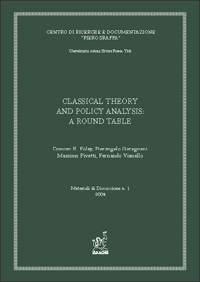Classical Theory and Policy Analysis
A Round-Table
Area 13 – Scienze economiche e statistiche
Tweet
SINTESI
In May 2001 Professor Foley, then in Rome as a guest of the “La Sapienza” University, was invited to the Centro Sraffa at the “Roma Tre” University to present a review article he had just written on a collection of essays regarding the resumption of classical theory. The result was the roundtable printed in this first number of our Materiali di Discussione. The interest which prompted the invitation was twofold. On the one hand, Foley’s attentive examination provided an opportunity to discuss some points of the theory of distribution and, more generally, of the social-surplus-centered view which the old classical economists took of the economy, with the resulting composite method of their analysis: deductive for the effects of competition on commodity prices; and mainly inductive with respect to distribution and growth. But the Centro’s interest in a discussion with Professor Foley was also a second, more specific one, consisting of his essay’s central thesis according to which “the classical literature [...] offers few demonstrations of the viability of applied classical political economy as an alternative to neoclassical practice” because it tells economists what not to do, but not “what they should do as an alternative”. This explains, Foley thought, why “despite the excellence and persuasiveness of [the “classical”] doctrinal critique”, neoclassical theory continues to dominate. We hope that this roundtable will contribute towards making more explicit the “viability” of applications of classical political economy, testified by the wealth and variety of the “applied economics” and “policy analyses” of Adam Smith, or Ricardo, or Marx. The problem, we suggest, may rather lie in taking too much for granted the shape and methods which applied economics and policy analysis have assumed within neoclassical theory over the last decades, while also underestimating some radical changes entailed in this field by the resumption of classical theory and by its critical implications. The radical nature of those changes follows from two elements: (i) the compatibility between classical free competition and permanent labour unemployment; (ii) the relevance of the critique of neoclassical distribution in putting on a solid basis the possibility of aggregate demand deficiencies for a long period analysis, no less than for a short-period one. Once they have been solidly founded in theory, these two elements overturn the idea of a Pareto optimality of free competition. The stress of policy analysis shifts then from the allocation of resources to the growth and the distribution of the social product — and with that to a recognition of the centrality for economic policy of conflicts of interest and power within the community. If this means that policy analysis loses in the ease of the neoclassical “routine predictions” which Foley rightly recalls, it may gain from being able to close the gap with a practice in which conflicts and power relations have long been dealt with in all but theory.
| pagine: | 72 |
| formato: | 17 x 24 |
| ISBN: | 978-88-7999-740-9 |
| data pubblicazione: | Dicembre 2015 |
| marchio editoriale: | Aracne |
| collana: | Centro di Ricerche e Documentazione “Piero Sraffa” dell’Università degli Studi Roma Tre | 1 |

SINTESI













